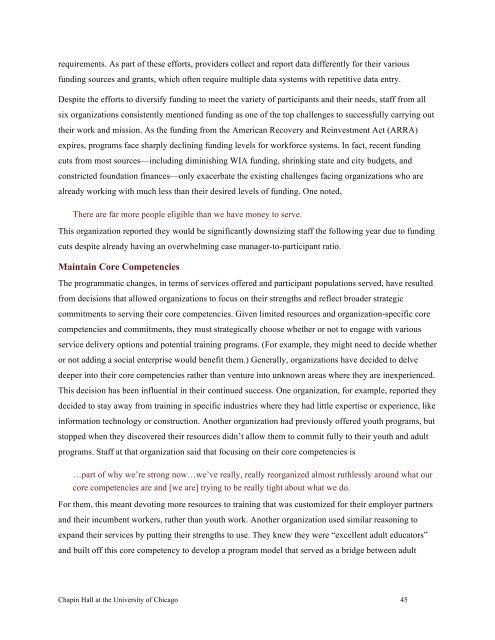Inside the Black Box - Chapin Hall at the University of Chicago
Inside the Black Box - Chapin Hall at the University of Chicago
Inside the Black Box - Chapin Hall at the University of Chicago
- No tags were found...
Create successful ePaper yourself
Turn your PDF publications into a flip-book with our unique Google optimized e-Paper software.
equirements. As part <strong>of</strong> <strong>the</strong>se efforts, providers collect and report d<strong>at</strong>a differently for <strong>the</strong>ir various<br />
funding sources and grants, which <strong>of</strong>ten require multiple d<strong>at</strong>a systems with repetitive d<strong>at</strong>a entry.<br />
Despite <strong>the</strong> efforts to diversify funding to meet <strong>the</strong> variety <strong>of</strong> participants and <strong>the</strong>ir needs, staff from all<br />
six organiz<strong>at</strong>ions consistently mentioned funding as one <strong>of</strong> <strong>the</strong> top challenges to successfully carrying out<br />
<strong>the</strong>ir work and mission. As <strong>the</strong> funding from <strong>the</strong> American Recovery and Reinvestment Act (ARRA)<br />
expires, programs face sharply declining funding levels for workforce systems. In fact, recent funding<br />
cuts from most sources—including diminishing WIA funding, shrinking st<strong>at</strong>e and city budgets, and<br />
constricted found<strong>at</strong>ion finances—only exacerb<strong>at</strong>e <strong>the</strong> existing challenges facing organiz<strong>at</strong>ions who are<br />
already working with much less than <strong>the</strong>ir desired levels <strong>of</strong> funding. One noted,<br />
There are far more people eligible than we have money to serve.<br />
This organiz<strong>at</strong>ion reported <strong>the</strong>y would be significantly downsizing staff <strong>the</strong> following year due to funding<br />
cuts despite already having an overwhelming case manager-to-participant r<strong>at</strong>io.<br />
Maintain Core Competencies<br />
The programm<strong>at</strong>ic changes, in terms <strong>of</strong> services <strong>of</strong>fered and participant popul<strong>at</strong>ions served, have resulted<br />
from decisions th<strong>at</strong> allowed organiz<strong>at</strong>ions to focus on <strong>the</strong>ir strengths and reflect broader str<strong>at</strong>egic<br />
commitments to serving <strong>the</strong>ir core competencies. Given limited resources and organiz<strong>at</strong>ion-specific core<br />
competencies and commitments, <strong>the</strong>y must str<strong>at</strong>egically choose whe<strong>the</strong>r or not to engage with various<br />
service delivery options and potential training programs. (For example, <strong>the</strong>y might need to decide whe<strong>the</strong>r<br />
or not adding a social enterprise would benefit <strong>the</strong>m.) Generally, organiz<strong>at</strong>ions have decided to delve<br />
deeper into <strong>the</strong>ir core competencies ra<strong>the</strong>r than venture into unknown areas where <strong>the</strong>y are inexperienced.<br />
This decision has been influential in <strong>the</strong>ir continued success. One organiz<strong>at</strong>ion, for example, reported <strong>the</strong>y<br />
decided to stay away from training in specific industries where <strong>the</strong>y had little expertise or experience, like<br />
inform<strong>at</strong>ion technology or construction. Ano<strong>the</strong>r organiz<strong>at</strong>ion had previously <strong>of</strong>fered youth programs, but<br />
stopped when <strong>the</strong>y discovered <strong>the</strong>ir resources didn’t allow <strong>the</strong>m to commit fully to <strong>the</strong>ir youth and adult<br />
programs. Staff <strong>at</strong> th<strong>at</strong> organiz<strong>at</strong>ion said th<strong>at</strong> focusing on <strong>the</strong>ir core competencies is<br />
…part <strong>of</strong> why we’re strong now…we’ve really, really reorganized almost ruthlessly around wh<strong>at</strong> our<br />
core competencies are and [we are] trying to be really tight about wh<strong>at</strong> we do.<br />
For <strong>the</strong>m, this meant devoting more resources to training th<strong>at</strong> was customized for <strong>the</strong>ir employer partners<br />
and <strong>the</strong>ir incumbent workers, ra<strong>the</strong>r than youth work. Ano<strong>the</strong>r organiz<strong>at</strong>ion used similar reasoning to<br />
expand <strong>the</strong>ir services by putting <strong>the</strong>ir strengths to use. They knew <strong>the</strong>y were “excellent adult educ<strong>at</strong>ors”<br />
and built <strong>of</strong>f this core competency to develop a program model th<strong>at</strong> served as a bridge between adult<br />
<strong>Chapin</strong> <strong>Hall</strong> <strong>at</strong> <strong>the</strong> <strong>University</strong> <strong>of</strong> <strong>Chicago</strong> 45
















